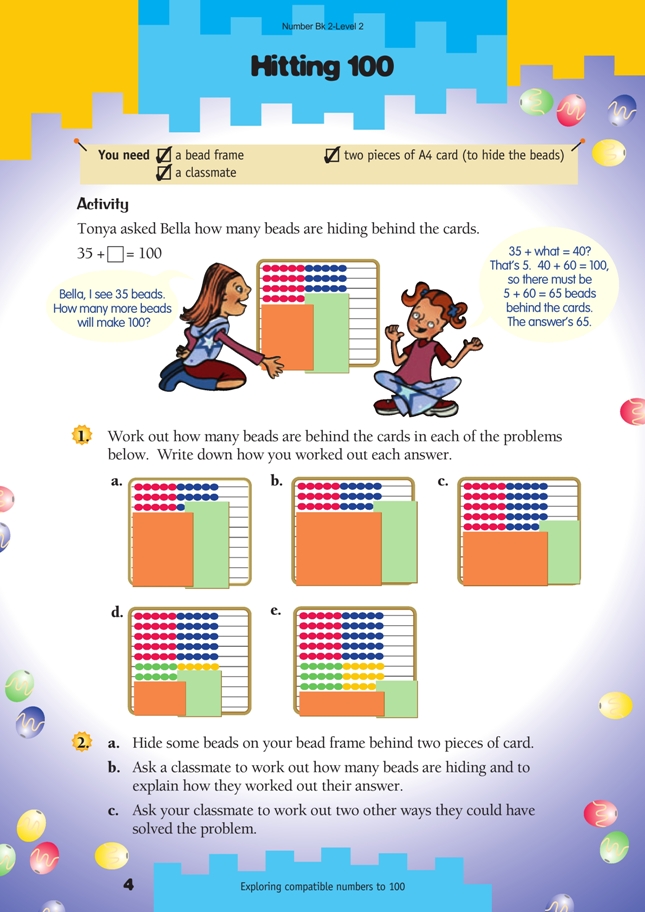This is a level 2 number activity from the Figure It Out series. It relates to Stage 5 of the Number Framework.
A PDF of the student activity is included.
Click on the image to enlarge it. Click again to close. Download PDF (268 KB)
explore compatible numbers to 100
FIO, Level 2, Number, Book 2, Hitting 100, page 4
Two pieces of A4 card (to hide the beads)
A classmate
This activity is designed to develop the students’ ability to visualise 100 represented on a bead frame and to know what numbers can be joined to make 100 (that is, compatible numbers).
Make sure that they understand the structure of the bead frame. Let them discover that there are 100 beads in 10 rows of 10 and that each row is split into two sets of 5. There are 25 beads of each colour, so each quadrant of the frame has 25 in it. Spend some time counting with the frame while all the beads are visible. Firstly reinforce groupings such as 20 + 80, 40 + 60, then move on to groupings such as 35 + 65, 25 + 75, and finally move to groupings such as 23 + 77 and 38 + 62.
Encourage the students to verbalise the different strategies they are using to work out how many more they need to make 100.
Students who use counting on and skip-counting as their strategy for adding will solve these problems by counting on in ones to make the next decade and then skip-counting in tens to reach 100. For example, for question 1:
“26 ... 27, 28, 29, 30 (that’s 4)
30 ... 40, 50, 60, 70, 80, 90, 100 (that’s 70)
so 70 + 4 = 74
26 + 74 = 100”
Students who can use part-whole strategies will solve these problems by partitioning the tens and ones to form 100. They are also more likely to use their knowledge of basic facts and apply it to larger numbers. For example, they would approach question 1a in this way:
“Start with 26: 6 + 4 = 10, so 26 + 4 = 30
3 + 7 = 10, so 30 + 70 = 100
so 70 + 4 = 74
26 + 74 = 100”
For question 2, the students need to know the answers themselves before they ask their classmates.
It’s a good idea to have them design the question and record their answer and strategy for solving it before they pose the problem to their classmates. The classmates can then solve the problem and record their answer and strategy, and then each pair can compare their answers and strategies together.
Answers to Activity
1. a. 26 + = 100?
26 + = 30, that’s 4
30 + 70 = 100, so there are 4 + 70 = 74 beads
b. 29 + = 100?
29 + = 30, that’s 1
30 + 70 = 100, so there are 1 + 70 = 71 beads
c. 49 + = 100?
49 + = 50, that’s 1
50 + 50 = 100, so there are 1 + 50 = 51 beads
d. 65 + = 100?
65 + = 70, that’s 5
70 + 30 = 100, so there are 5 + 30 = 35 beads
e. 79 + = 100?
79 + = 80, that’s 1
80 + 20 = 100, so there are 1 + 20 = 21 beads
2. Practical activity
